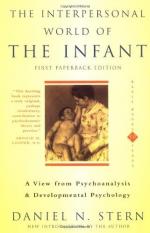
|
| Name: _________________________ | Period: ___________________ |
This test consists of 15 multiple choice questions and 5 short answer questions.
Multiple Choice Questions
1. Just as ________ develop, according to Stern, so must the theories about what they experience and who they are.
(a) Adults.
(b) Narratives.
(c) Therapists.
(d) Infants.
2. _________ of sense of self also help to identify a helpful narrative point of origin for the therapist when working with a client.
(a) Words.
(b) Activities.
(c) Interactions.
(d) Domains.
3. The experience of the answer in #140 might be felt as the dissolution of the core sense of ________.
(a) Possibility.
(b) Health.
(c) Self.
(d) Anger.
4. Stern says that more __________ is needed since the ideas he presents in this book are merely hypotheses.
(a) Experimentation.
(b) Research.
(c) Support.
(d) Infant case studies.
5. With language, the self and the ________ can now relate in an enormous number of ways and with shared varied meanings.
(a) Parent.
(b) World.
(c) Teacher.
(d) Other.
6. When searching for causes of ________ personality disorder, for example, different theories look for an experience of abandonment or isolation as a cause.
(a) Mood.
(b) Anxiety.
(c) Paranoid.
(d) Borderline.
7. At times, search strategies and certain therapeutic approaches cause therapists to overemphasize some problems in _______, while ignoring others.
(a) Movement.
(b) Emergence.
(c) Families.
(d) Development.
8. The process of ___________ and separation is not stage-specific but is ongoing throughout a life, as the self/other barrier is always being negotiated.
(a) Action.
(b) Learning.
(c) Individuation.
(d) Movement.
9. Infants must understand the idea of __________, or their execution of the act and the ability to change between the two realities.
(a) Reversibility.
(b) Interaction.
(c) Results.
(d) Perfection.
10. In Stern's mind, psychopathology should be seen as manifesting in a continuum of pattern ______________.
(a) Aggression.
(b) Emergence.
(c) Definition.
(d) Accumulation.
11. Self psychology, according to Stern, offers the most ________ value when it suggests search strategies that help construct life narratives.
(a) Academic.
(b) Medical.
(c) Personal.
(d) Clinical.
12. Children, at this time, also begin to use personal _______ when referring to themselves and others, and they begin to engage in empathic acts.
(a) Subjects.
(b) Pronouns.
(c) Movements.
(d) Adjectives.
13. The interpersonal ______ created by attunement is crucial for helping an infant realize that internal feeling states can be shared with others.
(a) Aspecting.
(b) Education.
(c) Conversation.
(d) Communion.
14. Stern believes that the capacities which tie diverse experiences of the social world together are largely determined by _________.
(a) Myths.
(b) Books.
(c) Genetics.
(d) Environment.
15. Few therapists, according to Stern, believe the idea of the ________ has any special significance in development.
(a) Ear.
(b) Hand.
(c) Eye.
(d) Mouth.
Short Answer Questions
1. Attunement is often seen as a stepping stone to __________, according to some researchers.
2. Stern begins to discuss how the client and patient should reconstruct an effective _________ about the past.
3. __________ intensity, according to Stern, may not be the decisive influence that many have thought it to be.
4. Non-__________ is a situation in which the infant is unable to engage in an attunement of affect, as in the case of being around a mentally unstable person.
5. Stern states that affect attunement is a form of __________, rather than something else entirely.
|
This section contains 459 words (approx. 2 pages at 300 words per page) |

|




